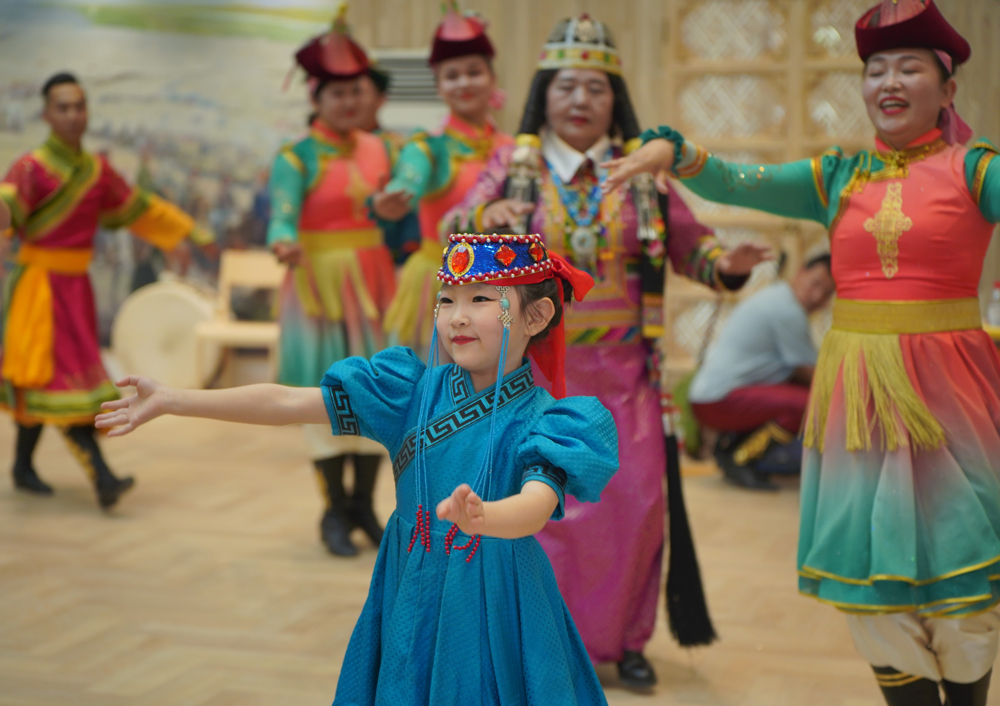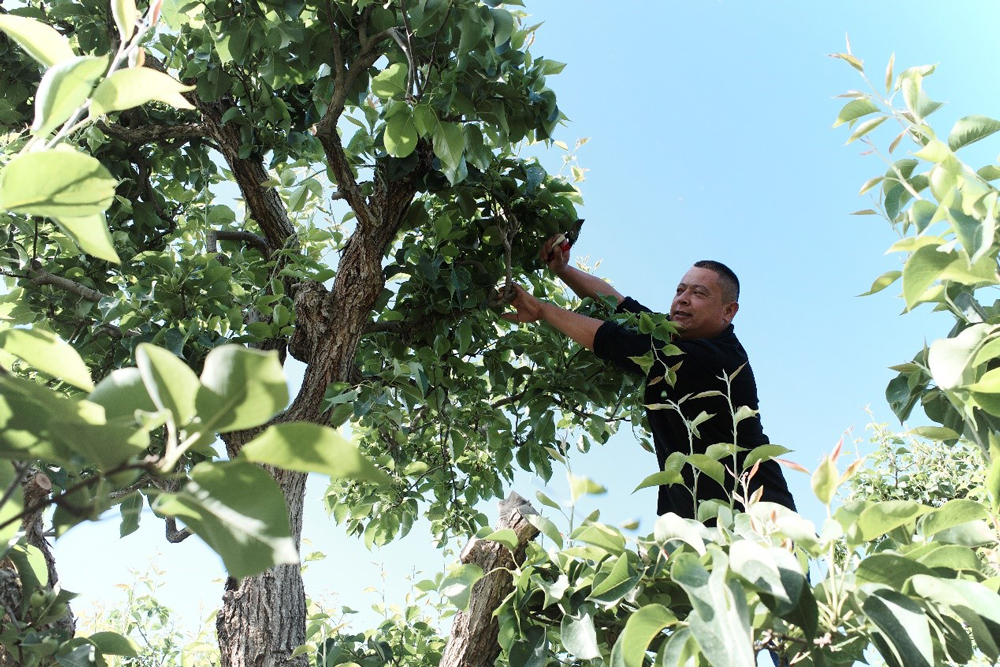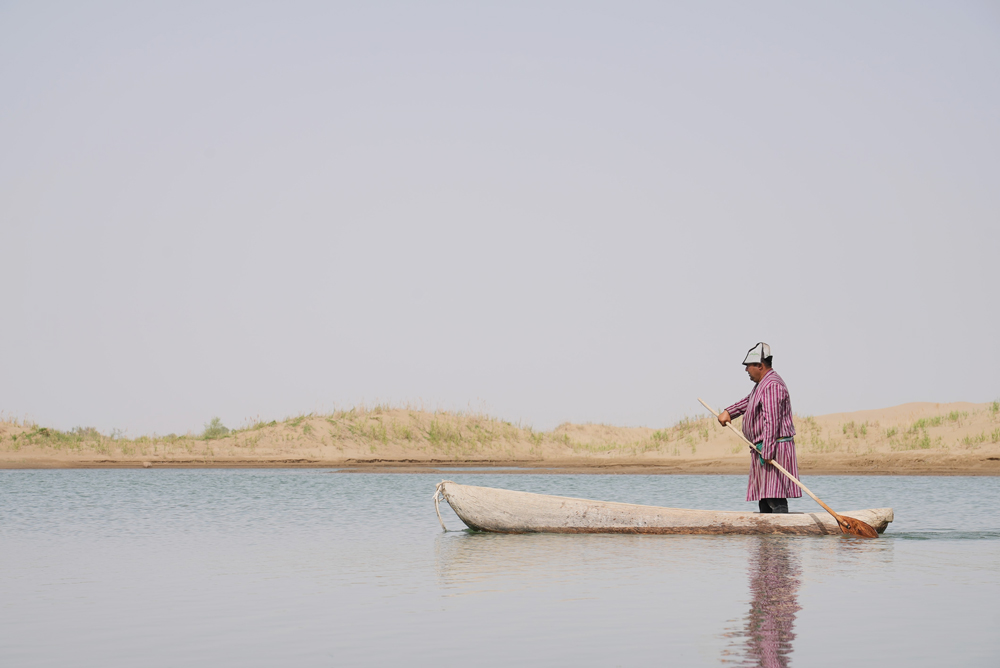
People in ethnic costumes dance at People's Square in Korla, northwest China's Xinjiang Uygur Autonomous Region, May 23, 2021. (People's Daily Online/Zhang Ruohan)
Korla is the seat of Bayingolin Mongol Autonomous Prefecture, and has been home to a sizeable Mongolian community in southeastern Xinjiang for centuries. Located near the center of Xinjiang, Korla has served as an important transportation hub and material distribution center along the Silk Road. As the second-largest city in Xinjiang, Korla has long enjoyed a certain degree of prosperity, boasting a convenient transportation system and ample entertainment facilities. The city’s main public space, People’s Square, is one of the places often frequented by locals seeking to enjoy their leisure time. In the afternoon, People’s Square is bustling with people sauntering around, playing chess, and dancing.

A Mongolian girl in her traditional ethnic dress dances along with accompanying dancers in Korla, northwest China's Xinjiang Uygur Autonomous Region, May 24, 2021. (People's Daily Online/Zhang Ruohan).
Korla is the seat of Bayingolin Mongol Autonomous Prefecture, and has been home to a sizeable Mongolian community in southeastern Xinjiang for centuries. China’s Mongolian peoples form one of the country’s 55 ethnic minority groups. The Mongolians are famous for their nomadic culture, and they love taking part in festive dancing and singing. Their style of dance is unique for its rhythmic movements and rich choreography.

Reyimjan Memet, a farmer of fragrant pears, prunes his fragrant pear tree in Korla, northwest China's Xinjiang Uygur Autonomous Region, May 23, 2021. (People's Daily Online/Kou Jie)
Korla is dubbed as "Pear City" because of its fragrant pears, which is one of China's most popular fruits. Located on the northern edge of the Taklamakan Desert, Korla is an oasis city enjoying lots of sunshine and plenty of rainfall, creating perfect conditions for growing the fragrant pear. Korla's pear planting history can be traced back 2000 years ago to when Zhang Qian, an envoy from the Han Dynasty, first introduced this fruit to the region. Now, the pear planting business is a prosperous industry in Korla, which helps farmers increase their incomes and alleviate poverty.

Three Lop Nur villagers chat in front of a house, enjoying a pleasant afternoon in Yuli County, northwest China’s Xinjiang Autonomous Region, May 25, 2021. (People's Daily Online/Zhang Ruohan)
Located in the Tarim Basin, the Lop Nur People Village, situated at the terminal point where the Tarim River flows through the desert, is famous for its natural scenery and the long life expectancy of its residents. As one of the oldest indigenous populations living in the Taklamakan Desert, the roots of the Lop Nur people can be traced back thousands of years to when they used to survive by fishing in the nearby lake. Their descendants are now considered a sub-ethnicity to the Uygur people in China. Today, most of the Lop Nur people live in Yuli County in Xinjiang. The village of Lop Nur is one of the largest villages in western China and a popular tourist destination, attracting tourists from home and abroad hoping to enjoy the exhilarating desert scenery and experience the traditional local ethnic culture.

Qasim Amudun rows a wooden canoe used for fishing at the Lop Nur People Village in Yuli County, northwest China's Xinjiang Uygur Autonomous Region, May 25, 2021. (People's Daily Online/Zhang Ruohan)
Located in the Tarim Basin, the Lop Nur People Village, situated at the terminal point where the Tarim River flows through the desert, is famous for its natural scenery and the long life expectancy of its residents. As one of the oldest indigenous populations living in the Taklamakan Desert, the roots of the Lop Nur people can be traced back thousands of years to when they used to survive by fishing in the nearby lake. The Lop Nur people have now integrated into the wider population and have various options to sustain their livelihoods. Improvements in infrastructure over the years has boosted the number of inbound tourists, which has in turn created more jobs for the local Lop Nur people. Qasim Amudun works in the local tourism industry, rowing a wooden canoe for tourists made from a desert poplar tree.

Tourists go sightseeing in the desert on camelback in the Lop Nur People Village in Yuli County, northwest China's Xinjiang Uygur Autonomous Region, May 25, 2021. (People's Daily Online/Zhang Ruohan)
Located in the Tarim Basin, the Lop Nur People Village, situated at the terminal point where the Tarim River flows through the desert, is famous for its natural scenery and the long life expectancy of its residents. As one of the oldest indigenous populations living in the Taklamakan Desert, the roots of the Lop Nur people can be traced back thousands of years to when they used to survive by fishing in the nearby lake. Their descendants are now considered a sub-ethnicity to the Uygur people in China. Today, most of the Lop Nur people live in Yuli County in Xinjiang. The village of Lop Nur is one of the largest villages in western China and a popular tourist destination, attracting tourists from home and abroad hoping to enjoy the exhilarating desert scenery and experience the local traditional ethnic culture. The thriving tourism industry has benefited the locals in Lop Nur village, creating more job opportunities for its residents. The people of Lop Nur can sell varieties of their famous roast fish and handcrafted model canoes to inbound tourists during the busy vacationing seasons.








